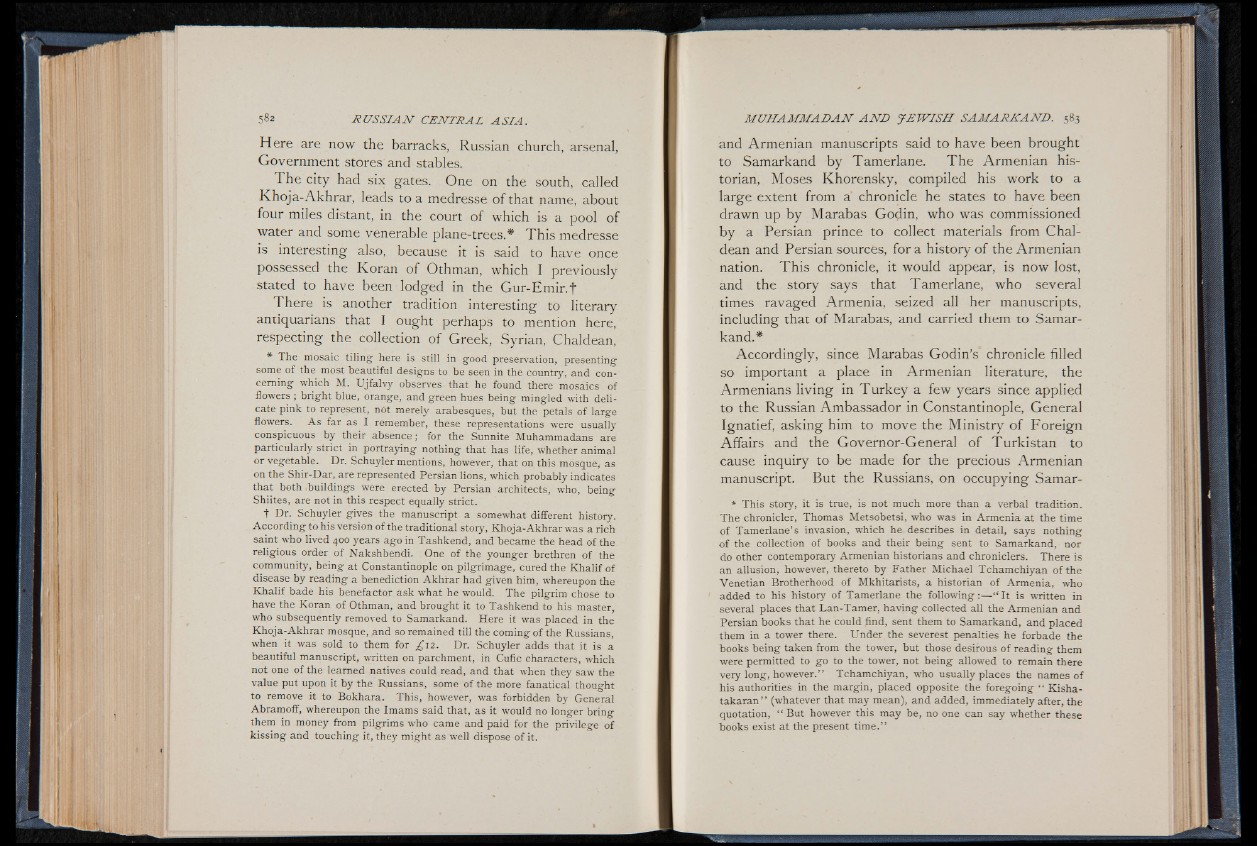
Here are now the barracks, Russian church, arsenal,
Government stores' and stables.
The city had six gates. One on the south, called
Khoja-Akhrar, leads to a medresse of that name, about
four miles distant, in the court of which is a pool of
water and some venerable plane-trees.* This medresse
is interesting also, because it is said to have once
possessed the Koran of Othman, which I previously
stated to have been lodged in the Gur-Emir.f
There is another tradition interesting to literary
antiquarians that I ought perhaps to mention here,
respecting the collection of Greek, Syrian, Chaldean,
* The mosaic tiling here is still in good preservation, presenting
some of the most beautiful designs to be seen in the country, and concerning
which M. Ujfalvy observes that he found there mosaics of
flowers ; bright blue, orange, and green hues being mingled with delicate
pink to represent, not merely arabesques, but the petals of large
flowers. A s far as I remember, these representations were usually
conspicuous by their absence; for the Sunnite Muhammadans are
particularly strict in portraying nothing that has life, whether animal
or vegetable. Dr. Schuyler mentions, however, that on this mosque^ as
on the Shir-Dar, are represented Persian lions, which probably indicates
that both .buildings were erected by Persian architects, who, being
Shiites, are not in this respect equally strict.
t Dr. Schuyler gives the manuscript a somewhat different history.
According to his version o f the traditional story, Khoja-Akhrar was a rich
saint who lived 400 years ago in Tashkend, and became the head of the
religious order of Nakshbendi. One of the younger brethren of the
community, being at Constantinople on pilgrimage, cured the Kha lif of
disease by reading a benediction Akhrar had given him, whereupon the
Khalif bade his benefactor ask what he would. The pilgrim chose to
have the Koran of Othman, and brought it to Tashkend to his master,
who subsequently removed to Samarkand. Here it was placed in the
Khoja-Akhrar mosque, and so remained till the coming of the Russians,
when it was sold to them for ¿ \2 . Dr. Schuyler adds that it is a
beautiful manuscript, written on parchment, in Cufic characters, which
not one of the learned natives could read, and that when they saw the
value put upon it by the Russians, some of the more fanatical thought
to remove it to Bokhara. This, however, was forbidden by General
Abramoff, whereupon the Imams said that, as it would no longer bring
them in money from pilgrims who came and paid for the privilege of
kissiDg and touching it, they might as well dispose of it.
and Armenian manuscripts said to have been brought
to Samarkand by Tamerlane. The Armenian historian,
Moses Khorensky, compiled his work to a
large extent from a’ chronicle he states to have been
drawn up by Marabas Godin, who was commissioned
by a Persian prince to collect materials from Chaldean
and Persian sources, for a history of the Armenian
nation. This chronicle, it would appear, is now lost,
and the story says that Tamerlane, who several
times ravaged Armenia, seized all her manuscripts,
including that of Marabas, and carried them to Samarkand.*
Accordingly, since Marabas Godin’s chronicle filled
so important a place in Armenian literature, the
Armenians living in Turkey a few years since applied
to the Russian Ambassador in Constantinople, General
Ignatief, asking him to move the Ministry of Foreign
Affairs and the Governor-General of Turkistan to
cause inquiry to be made for the precious Armenian
manuscript. But the Russians, on occupying Samar-
* This story, it is true, is not much more than a verbal tradition.
The chronicler, Thomas Metsobetsi, who was in Armenia at the time
of Tamerlane’ s invasion, which he describes in detail, says nothing
of the collection of books and their being sent to Samarkand, nor
do other contemporary Armenian historians and chroniclers. There is
an allusion, however, thereto by Father Michael Tchamchiyan of the
Venetian Brotherhood of Mkhitarists, a historian of Armenia, who
added to his history of Tamerlane the following:— “ I t is written in
several places that Lan-Tamer, having collected all the Armenian and
Persian books that he could find, sent them to Samarkand, and placed
them in a tower there. Under the severest penalties he forbade the
books being taken from the tower, but those desirous o f reading them
were permitted to go to the tower, not being allowed to remain there
very long, however.” Tchamchiyan, who usually places the names of
his authorities in the margin, placed opposite the foregoing “ Kisha-
takaran” (whatever that may mean), and added, immediately after, the
quotation, “ But however this may be, no one can say whether these
books exist at the present time.”